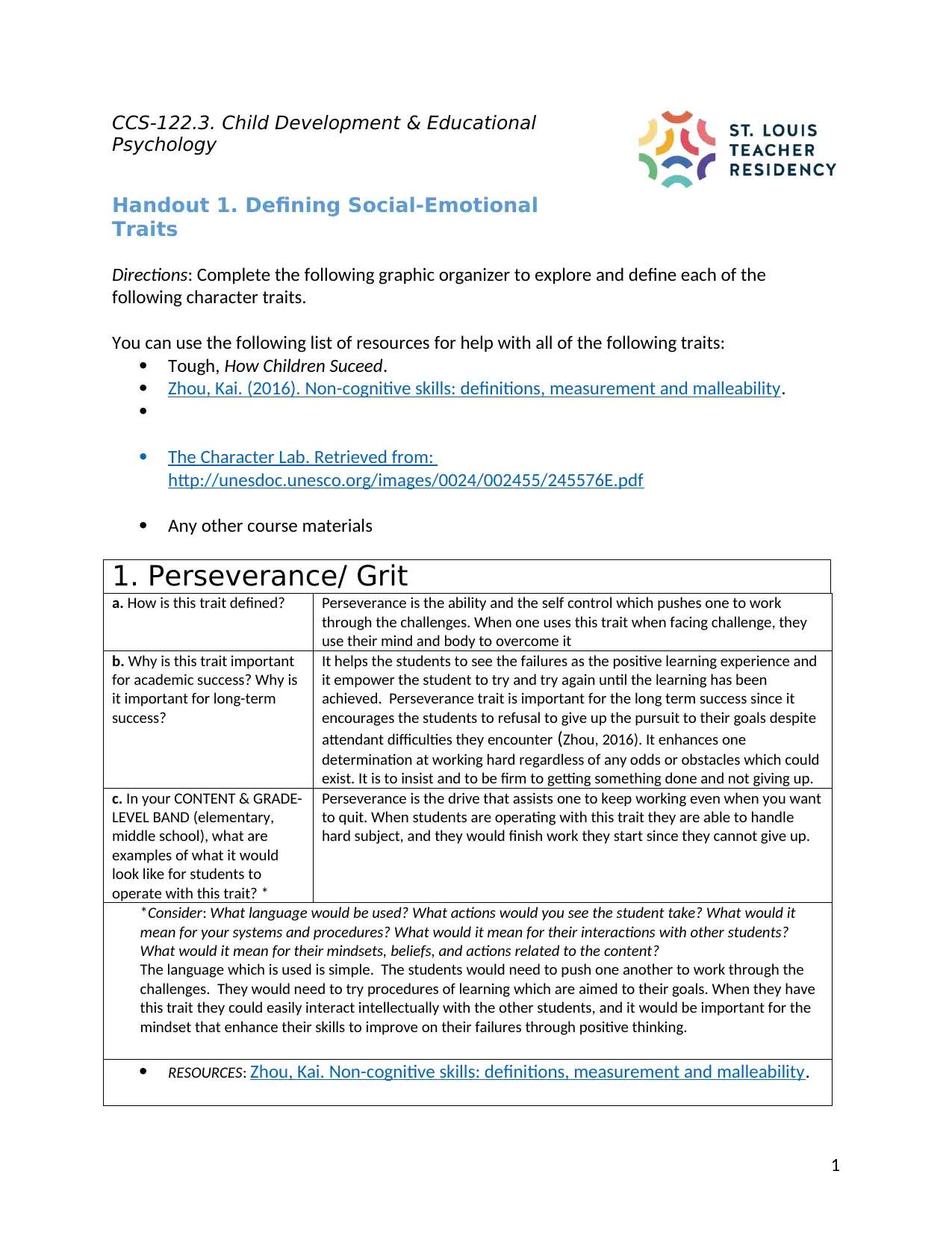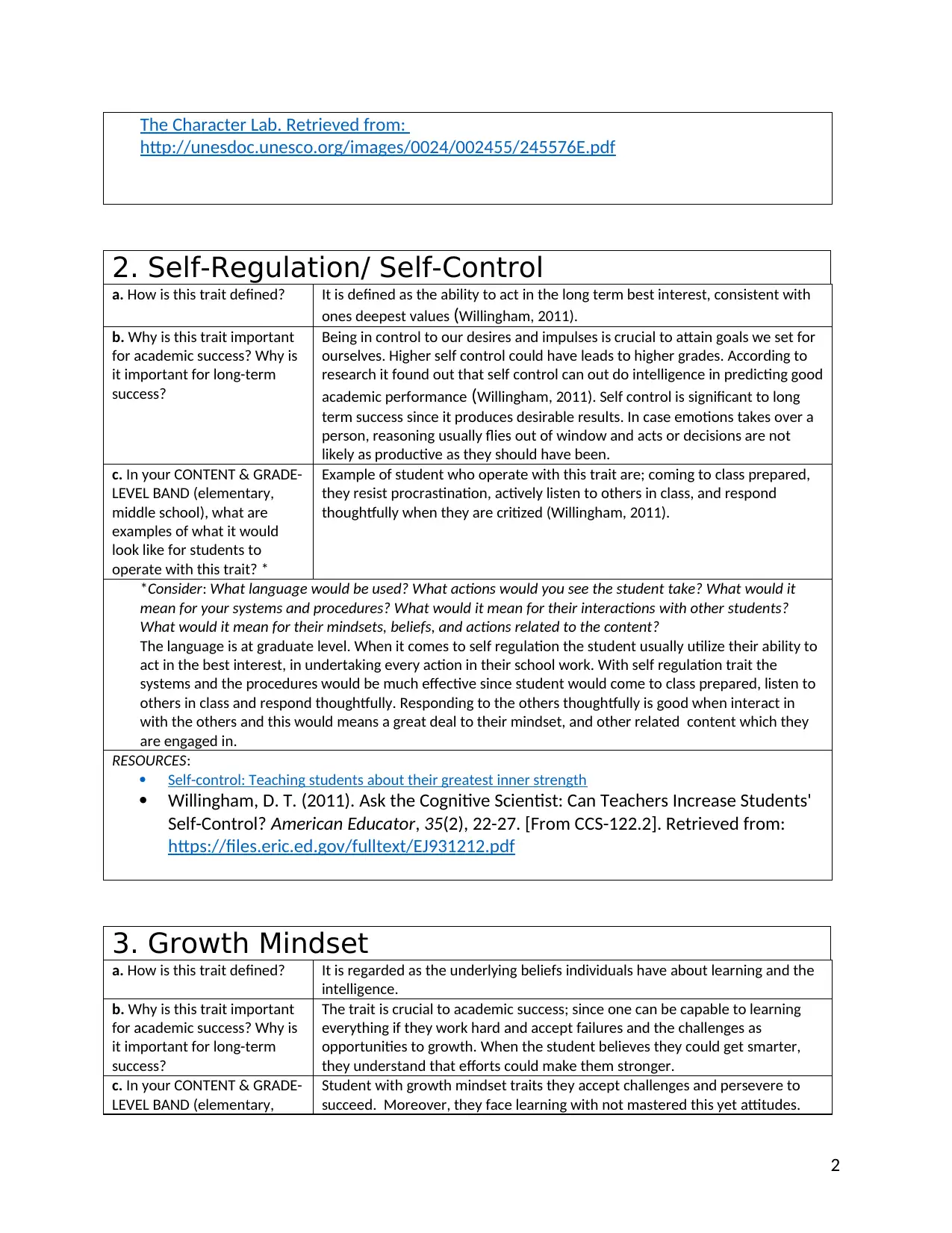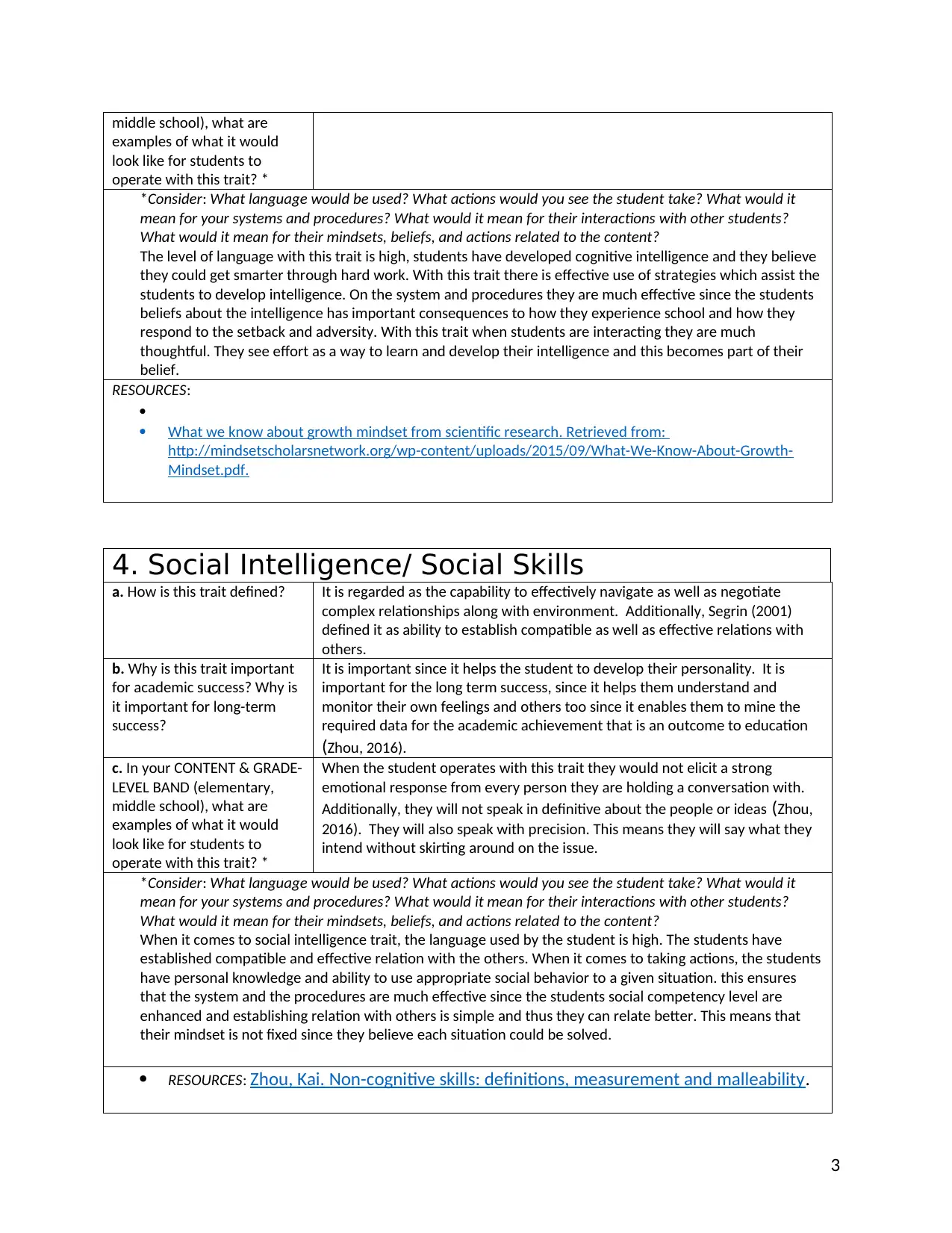CCS-122.3 Child Development: Analysis of Social-Emotional Traits
VerifiedAdded on 2023/06/09
|4
|1677
|420
Homework Assignment
AI Summary
This assignment focuses on defining and exploring social-emotional traits in child development, specifically perseverance/grit, self-regulation/self-control, growth mindset, and social intelligence/social skills. For each trait, the assignment requires a definition, an explanation of its importance for academic and long-term success, and examples of how students would operate with the trait in elementary or middle school settings, considering language, actions, systems, interactions, mindsets, and beliefs. The analysis includes relevant resources and emphasizes the practical application of these traits in educational contexts. Desklib offers a wide array of study tools and solved assignments to aid students in their academic journey.

CCS-122.3. Child Development & Educational
Psychology
Handout 1. Defining Social-Emotional
Traits
Directions: Complete the following graphic organizer to explore and define each of the
following character traits.
You can use the following list of resources for help with all of the following traits:
Tough, How Children Suceed.
Zhou, Kai. (2016). Non-cognitive skills: definitions, measurement and malleability.
The Character Lab. Retrieved from:
http://unesdoc.unesco.org/images/0024/002455/245576E.pdf
Any other course materials
1. Perseverance/ Grit
a. How is this trait defined? Perseverance is the ability and the self control which pushes one to work
through the challenges. When one uses this trait when facing challenge, they
use their mind and body to overcome it
b. Why is this trait important
for academic success? Why is
it important for long-term
success?
It helps the students to see the failures as the positive learning experience and
it empower the student to try and try again until the learning has been
achieved. Perseverance trait is important for the long term success since it
encourages the students to refusal to give up the pursuit to their goals despite
attendant difficulties they encounter (Zhou, 2016). It enhances one
determination at working hard regardless of any odds or obstacles which could
exist. It is to insist and to be firm to getting something done and not giving up.
c. In your CONTENT & GRADE-
LEVEL BAND (elementary,
middle school), what are
examples of what it would
look like for students to
operate with this trait? *
Perseverance is the drive that assists one to keep working even when you want
to quit. When students are operating with this trait they are able to handle
hard subject, and they would finish work they start since they cannot give up.
*Consider: What language would be used? What actions would you see the student take? What would it
mean for your systems and procedures? What would it mean for their interactions with other students?
What would it mean for their mindsets, beliefs, and actions related to the content?
The language which is used is simple. The students would need to push one another to work through the
challenges. They would need to try procedures of learning which are aimed to their goals. When they have
this trait they could easily interact intellectually with the other students, and it would be important for the
mindset that enhance their skills to improve on their failures through positive thinking.
RESOURCES: Zhou, Kai. Non-cognitive skills: definitions, measurement and malleability.
1
Psychology
Handout 1. Defining Social-Emotional
Traits
Directions: Complete the following graphic organizer to explore and define each of the
following character traits.
You can use the following list of resources for help with all of the following traits:
Tough, How Children Suceed.
Zhou, Kai. (2016). Non-cognitive skills: definitions, measurement and malleability.
The Character Lab. Retrieved from:
http://unesdoc.unesco.org/images/0024/002455/245576E.pdf
Any other course materials
1. Perseverance/ Grit
a. How is this trait defined? Perseverance is the ability and the self control which pushes one to work
through the challenges. When one uses this trait when facing challenge, they
use their mind and body to overcome it
b. Why is this trait important
for academic success? Why is
it important for long-term
success?
It helps the students to see the failures as the positive learning experience and
it empower the student to try and try again until the learning has been
achieved. Perseverance trait is important for the long term success since it
encourages the students to refusal to give up the pursuit to their goals despite
attendant difficulties they encounter (Zhou, 2016). It enhances one
determination at working hard regardless of any odds or obstacles which could
exist. It is to insist and to be firm to getting something done and not giving up.
c. In your CONTENT & GRADE-
LEVEL BAND (elementary,
middle school), what are
examples of what it would
look like for students to
operate with this trait? *
Perseverance is the drive that assists one to keep working even when you want
to quit. When students are operating with this trait they are able to handle
hard subject, and they would finish work they start since they cannot give up.
*Consider: What language would be used? What actions would you see the student take? What would it
mean for your systems and procedures? What would it mean for their interactions with other students?
What would it mean for their mindsets, beliefs, and actions related to the content?
The language which is used is simple. The students would need to push one another to work through the
challenges. They would need to try procedures of learning which are aimed to their goals. When they have
this trait they could easily interact intellectually with the other students, and it would be important for the
mindset that enhance their skills to improve on their failures through positive thinking.
RESOURCES: Zhou, Kai. Non-cognitive skills: definitions, measurement and malleability.
1
Paraphrase This Document
Need a fresh take? Get an instant paraphrase of this document with our AI Paraphraser

The Character Lab. Retrieved from:
http://unesdoc.unesco.org/images/0024/002455/245576E.pdf
2. Self-Regulation/ Self-Control
a. How is this trait defined? It is defined as the ability to act in the long term best interest, consistent with
ones deepest values (Willingham, 2011).
b. Why is this trait important
for academic success? Why is
it important for long-term
success?
Being in control to our desires and impulses is crucial to attain goals we set for
ourselves. Higher self control could have leads to higher grades. According to
research it found out that self control can out do intelligence in predicting good
academic performance (Willingham, 2011). Self control is significant to long
term success since it produces desirable results. In case emotions takes over a
person, reasoning usually flies out of window and acts or decisions are not
likely as productive as they should have been.
c. In your CONTENT & GRADE-
LEVEL BAND (elementary,
middle school), what are
examples of what it would
look like for students to
operate with this trait? *
Example of student who operate with this trait are; coming to class prepared,
they resist procrastination, actively listen to others in class, and respond
thoughtfully when they are critized (Willingham, 2011).
*Consider: What language would be used? What actions would you see the student take? What would it
mean for your systems and procedures? What would it mean for their interactions with other students?
What would it mean for their mindsets, beliefs, and actions related to the content?
The language is at graduate level. When it comes to self regulation the student usually utilize their ability to
act in the best interest, in undertaking every action in their school work. With self regulation trait the
systems and the procedures would be much effective since student would come to class prepared, listen to
others in class and respond thoughtfully. Responding to the others thoughtfully is good when interact in
with the others and this would means a great deal to their mindset, and other related content which they
are engaged in.
RESOURCES:
Self-control: Teaching students about their greatest inner strength
Willingham, D. T. (2011). Ask the Cognitive Scientist: Can Teachers Increase Students'
Self-Control? American Educator, 35(2), 22-27. [From CCS-122.2]. Retrieved from:
https://files.eric.ed.gov/fulltext/EJ931212.pdf
3. Growth Mindset
a. How is this trait defined? It is regarded as the underlying beliefs individuals have about learning and the
intelligence.
b. Why is this trait important
for academic success? Why is
it important for long-term
success?
The trait is crucial to academic success; since one can be capable to learning
everything if they work hard and accept failures and the challenges as
opportunities to growth. When the student believes they could get smarter,
they understand that efforts could make them stronger.
c. In your CONTENT & GRADE-
LEVEL BAND (elementary,
Student with growth mindset traits they accept challenges and persevere to
succeed. Moreover, they face learning with not mastered this yet attitudes.
2
http://unesdoc.unesco.org/images/0024/002455/245576E.pdf
2. Self-Regulation/ Self-Control
a. How is this trait defined? It is defined as the ability to act in the long term best interest, consistent with
ones deepest values (Willingham, 2011).
b. Why is this trait important
for academic success? Why is
it important for long-term
success?
Being in control to our desires and impulses is crucial to attain goals we set for
ourselves. Higher self control could have leads to higher grades. According to
research it found out that self control can out do intelligence in predicting good
academic performance (Willingham, 2011). Self control is significant to long
term success since it produces desirable results. In case emotions takes over a
person, reasoning usually flies out of window and acts or decisions are not
likely as productive as they should have been.
c. In your CONTENT & GRADE-
LEVEL BAND (elementary,
middle school), what are
examples of what it would
look like for students to
operate with this trait? *
Example of student who operate with this trait are; coming to class prepared,
they resist procrastination, actively listen to others in class, and respond
thoughtfully when they are critized (Willingham, 2011).
*Consider: What language would be used? What actions would you see the student take? What would it
mean for your systems and procedures? What would it mean for their interactions with other students?
What would it mean for their mindsets, beliefs, and actions related to the content?
The language is at graduate level. When it comes to self regulation the student usually utilize their ability to
act in the best interest, in undertaking every action in their school work. With self regulation trait the
systems and the procedures would be much effective since student would come to class prepared, listen to
others in class and respond thoughtfully. Responding to the others thoughtfully is good when interact in
with the others and this would means a great deal to their mindset, and other related content which they
are engaged in.
RESOURCES:
Self-control: Teaching students about their greatest inner strength
Willingham, D. T. (2011). Ask the Cognitive Scientist: Can Teachers Increase Students'
Self-Control? American Educator, 35(2), 22-27. [From CCS-122.2]. Retrieved from:
https://files.eric.ed.gov/fulltext/EJ931212.pdf
3. Growth Mindset
a. How is this trait defined? It is regarded as the underlying beliefs individuals have about learning and the
intelligence.
b. Why is this trait important
for academic success? Why is
it important for long-term
success?
The trait is crucial to academic success; since one can be capable to learning
everything if they work hard and accept failures and the challenges as
opportunities to growth. When the student believes they could get smarter,
they understand that efforts could make them stronger.
c. In your CONTENT & GRADE-
LEVEL BAND (elementary,
Student with growth mindset traits they accept challenges and persevere to
succeed. Moreover, they face learning with not mastered this yet attitudes.
2

middle school), what are
examples of what it would
look like for students to
operate with this trait? *
*Consider: What language would be used? What actions would you see the student take? What would it
mean for your systems and procedures? What would it mean for their interactions with other students?
What would it mean for their mindsets, beliefs, and actions related to the content?
The level of language with this trait is high, students have developed cognitive intelligence and they believe
they could get smarter through hard work. With this trait there is effective use of strategies which assist the
students to develop intelligence. On the system and procedures they are much effective since the students
beliefs about the intelligence has important consequences to how they experience school and how they
respond to the setback and adversity. With this trait when students are interacting they are much
thoughtful. They see effort as a way to learn and develop their intelligence and this becomes part of their
belief.
RESOURCES:
What we know about growth mindset from scientific research. Retrieved from:
http://mindsetscholarsnetwork.org/wp-content/uploads/2015/09/What-We-Know-About-Growth-
Mindset.pdf.
4. Social Intelligence/ Social Skills
a. How is this trait defined? It is regarded as the capability to effectively navigate as well as negotiate
complex relationships along with environment. Additionally, Segrin (2001)
defined it as ability to establish compatible as well as effective relations with
others.
b. Why is this trait important
for academic success? Why is
it important for long-term
success?
It is important since it helps the student to develop their personality. It is
important for the long term success, since it helps them understand and
monitor their own feelings and others too since it enables them to mine the
required data for the academic achievement that is an outcome to education
(Zhou, 2016).
c. In your CONTENT & GRADE-
LEVEL BAND (elementary,
middle school), what are
examples of what it would
look like for students to
operate with this trait? *
When the student operates with this trait they would not elicit a strong
emotional response from every person they are holding a conversation with.
Additionally, they will not speak in definitive about the people or ideas (Zhou,
2016). They will also speak with precision. This means they will say what they
intend without skirting around on the issue.
*Consider: What language would be used? What actions would you see the student take? What would it
mean for your systems and procedures? What would it mean for their interactions with other students?
What would it mean for their mindsets, beliefs, and actions related to the content?
When it comes to social intelligence trait, the language used by the student is high. The students have
established compatible and effective relation with the others. When it comes to taking actions, the students
have personal knowledge and ability to use appropriate social behavior to a given situation. this ensures
that the system and the procedures are much effective since the students social competency level are
enhanced and establishing relation with others is simple and thus they can relate better. This means that
their mindset is not fixed since they believe each situation could be solved.
RESOURCES: Zhou, Kai. Non-cognitive skills: definitions, measurement and malleability.
3
examples of what it would
look like for students to
operate with this trait? *
*Consider: What language would be used? What actions would you see the student take? What would it
mean for your systems and procedures? What would it mean for their interactions with other students?
What would it mean for their mindsets, beliefs, and actions related to the content?
The level of language with this trait is high, students have developed cognitive intelligence and they believe
they could get smarter through hard work. With this trait there is effective use of strategies which assist the
students to develop intelligence. On the system and procedures they are much effective since the students
beliefs about the intelligence has important consequences to how they experience school and how they
respond to the setback and adversity. With this trait when students are interacting they are much
thoughtful. They see effort as a way to learn and develop their intelligence and this becomes part of their
belief.
RESOURCES:
What we know about growth mindset from scientific research. Retrieved from:
http://mindsetscholarsnetwork.org/wp-content/uploads/2015/09/What-We-Know-About-Growth-
Mindset.pdf.
4. Social Intelligence/ Social Skills
a. How is this trait defined? It is regarded as the capability to effectively navigate as well as negotiate
complex relationships along with environment. Additionally, Segrin (2001)
defined it as ability to establish compatible as well as effective relations with
others.
b. Why is this trait important
for academic success? Why is
it important for long-term
success?
It is important since it helps the student to develop their personality. It is
important for the long term success, since it helps them understand and
monitor their own feelings and others too since it enables them to mine the
required data for the academic achievement that is an outcome to education
(Zhou, 2016).
c. In your CONTENT & GRADE-
LEVEL BAND (elementary,
middle school), what are
examples of what it would
look like for students to
operate with this trait? *
When the student operates with this trait they would not elicit a strong
emotional response from every person they are holding a conversation with.
Additionally, they will not speak in definitive about the people or ideas (Zhou,
2016). They will also speak with precision. This means they will say what they
intend without skirting around on the issue.
*Consider: What language would be used? What actions would you see the student take? What would it
mean for your systems and procedures? What would it mean for their interactions with other students?
What would it mean for their mindsets, beliefs, and actions related to the content?
When it comes to social intelligence trait, the language used by the student is high. The students have
established compatible and effective relation with the others. When it comes to taking actions, the students
have personal knowledge and ability to use appropriate social behavior to a given situation. this ensures
that the system and the procedures are much effective since the students social competency level are
enhanced and establishing relation with others is simple and thus they can relate better. This means that
their mindset is not fixed since they believe each situation could be solved.
RESOURCES: Zhou, Kai. Non-cognitive skills: definitions, measurement and malleability.
3
⊘ This is a preview!⊘
Do you want full access?
Subscribe today to unlock all pages.

Trusted by 1+ million students worldwide

The Character Lab. Retrieved from:
http://unesdoc.unesco.org/images/0024/002455/245576E.pdf
4
http://unesdoc.unesco.org/images/0024/002455/245576E.pdf
4
1 out of 4
Related Documents
Your All-in-One AI-Powered Toolkit for Academic Success.
+13062052269
info@desklib.com
Available 24*7 on WhatsApp / Email
![[object Object]](/_next/static/media/star-bottom.7253800d.svg)
Unlock your academic potential
Copyright © 2020–2025 A2Z Services. All Rights Reserved. Developed and managed by ZUCOL.





